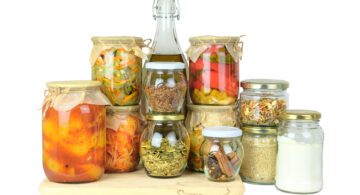Top 10 Essential Oils
The use of essential oils is based in a practice called aromatherapy. Aromatherapy uses volatile (quick to evaporate) aromatic plant oils to bring about spiritual, emotional and physical well-being. Essential oils provide healing in many ways including:
- Strengthening the immune system
- Penetrating cell walls to deliver nutrients and oxygen
- Neutralizing free radicals with antioxidant properties
- Killing bacteria, viruses and fungi[1]
- Detoxifying cells in the body
- Passing the blood-brain barrier to treat neurological issues
- Increasing ozone and negative ions in the air
- Raising the frequency of the human body. This fights disease and brings balance the physical, emotional, and spiritual health.[2]
- Acting on the central nervous system. Oils can relieve depression, anxiety, and stress and also bring focus and alertness.
- Bringing relief to pain and inflammation
Essential oils are not the same as fragrance or perfume. They are naturally potent medicines with constituents based in chemistry. Made of hydrocarbons and oxygenated compounds, essential oils have the potential to be as powerful as pharmaceutical drugs. This is why safely using these powerful and effective oils is so important!
There are three primary and safe methods of essential oil use:
- Inhalation
- Topical
- Internal
Inhalation of Essential Oils
The inhalation of oils is most effective on the central nervous system. When inhaling essential oils, the volatile molecules become a vapor. This vapor travels to the top of the nasal cavity and meet the olfactory mucous membrane. The olfactory membrane has thousands of sensory receptors to:
- Identify the smell.
- Convert the smell to an electrical charge.
- Send the frequency to the olfactory bulb.
The limbic system includes parts of the brain that control emotional and psychological responses. Once the charge reaches the limbic region, it stimulates the hypothalamus and continues to the autonomic nervous system or pituitary gland. Once the charge reaches the autonomic nervous system, it can affect body functions such as heart rate and digestion. Its effects on the pituitary gland can initiate hormonal activity in the body.
Through the process of inhalation, essential oils have the capacity to:
- Heal emotional trauma
- Stimulate memory
- Enhance focus and learning
- Decrease stress levels
- Balance hormones
- And much more!
The entire process from inhalation to response from the brain takes place in a matter of seconds![3] The oils also reach the bloodstream during inhalation via the nasal mucosa and the alveoli in the lungs. Certain oils, eucalyptus for example, can also have a direct effect on the lungs.
When inhaled, eucalyptus acts as a natural anti-inflammatory and expectorant. Click to Tweet.
Inhalation can be performed using an essential oil diffuser or an inhaler. Another way that essential oils enter the body is inhalation through the nose or mouth. Diffusers are also an excellent way:
- To neutralize odors
- Kill airborne bacteria and viruses
- Increase ozone in the air
I recommend using ultrasonic diffusers. They are the most effective at creating a fine mist of aromatic molecules. This inexpensive diffuser from NOW is a great introductory diffuser for a great price!
Applying diluted essential oil to the skin through a body oil or lotion is also a great way to incorporate the benefits of both inhalation and topical application.
Topical Use of Essential Oils
Topical application quickly gets the oils into the bloodstream by bypassing the digestive system. When applied to the skin, essential oil molecules pass through dermis of the skin, into the capillaries and then into the bloodstream.
Essential oils can be quickly absorbed through the feet. The feet contain bundles of nerve endings. These nerve endings act as neuroelectrical pathways to different organs throughout the body. Applying oils to the corresponding points on the feet allows healing to reach the particular affected organ.
For example, if you are nauseous, then apply peppermint to the stomach and intestinal locations on the feet.
Applying certain essential oils, such as peppermint, close to the chest or face of a small child is strongly discouraged due to risk of bronchospasm. Applying essential oils (always diluted) to their feet instead is a great, safer way for small children to get the topical benefits of essential oils.
Using a reflexology or vita flex chart gives you a visual mapping of where to apply the oils on the feet to treat a particular organ. Other great application points are:
- The back of the neck
- Inside the wrist
- The temples
- Sternum
- The area that the pain originates (back, leg, stomach, etc).
One of the most important safety concerns when using essential oils is NEVER to apply undiluted (also called neat) essential oils to the skin. I constantly see recommendations for undiluted application from non-professionals. However, aromatherapists do not recommend this practice! Certain essential oils companies recommend undiluted application only so they can sell more oil!
When oils are not diluted, sensitization can occur. Sensitization begins with a skin rash or skin irritation. Once this occurs, this oil can never be used again without the same reaction! This reaction is an allergic response that can even lead to respiratory distress or anaphylactic shock! Diluting oils not only protects you from sensitivity reactions, it also saves you money!
Some say that lavender and tea tree oil can safely be used without dilution. But all other oils must be diluted with a carrier oil to avoid damaging consequences to the skin.
The recommended correct dilution for topical application is:- 1% for children and pregnant women
- 2% for adults
- 3%-5% for medicinal use
The most effective way to dilute essential oils is in carrier oil. Some great carrier oils to use for blending include:
- Fractionated coconut oil: Fractionated coconut oil is a “fraction” of regular coconut oil. The unsaturated portions have been removed to create very shelf-stable oil. It is a light, non-greasy and absorbs better than regular coconut oil. It is also liquid at room temperature making it better for mixing.
- Jojoba
- Almond oil
- Grapeseed oil
- Apricot oil
Use this reference for easy dilution:
- 1 tsp carrier oil + 1 drop of essential oil = 1% dilution
- 1 tsp carrier oil + 2 drops of essential oil = 2% dilution
- 1 tsp carrier oil + 3 drops of essential oil = 3% dilution
- 1 tsp carrier oil + 5 drops of essential oil = 5% dilution
Internal Use of Essential Oils
Internal use of essential oils is highly controversial. for a complete breakdown of safe and unsafe internal use, I encourage you to read my article Are Essential Oils Safe for Internal Use? Internal use of essential oils should be used very sparingly. Though some internal supplementation of oils can be beneficial, daily use can cause damage to the body’s internal organs. Inhalation and topical applications are the safest and most effective application methods.
Top 10 Essential Oils
You know now what essential oil are, from which reputable companies to purchase them and how to use them. Now, you might be wondering, where do I start? Below are my top essential oils that are great for beginners. These oils work on a variety of ailments and make a great “first aid” essential oil kit. The uses listed are just a few of the HUNDREDS of medicinal uses of these oils! I also recommend purchasing a small essential oil manual to read about each oil’s use and application recommendations.
Frankincense
Used for depression, inflammation, mental fatigue, warts, wrinkles, skin infections, allergies, and asthma.
Myrrh
Treats thyroid problems, eczema, impetigo, wounds, chapped and cracked skin, and stretch marks.
Lavender
Used for anxiety, allergies, high blood pressure, headaches, burns, insomnia, and poor concentration.
Melaleuca (Tea Tree)
Used for acne, cold sores, dandruff, ringworm, rashes, yeast infections, athletes foot, toe fungus, and thrush.
Grapefruit
Used for appetite suppression, postpartum depression, weight loss, fatigue, gallstones, jet lag, and cellulite. Add 30 drops of grapefruit essential oil to 1 cup of coconut oil for an amazing cellulite cream. Deeply massage this mixture into areas of cellulite twice a day for smoother skin!
Lemon
Used for air purification, disinfection (added to cleaning products), constipation, gout, kidney stones, and varicose veins.
Eucalyptus
Used for asthma, bronchitis, carpal tunnel, hypoglycemia, pain, sinusitis, sore throat, and neuralgia.
Oregano
Used for bacterial and viral infections, fungus, parasites, pneumonia and staph/MRSA.
Peppermint
Used for bad breath, alertness, energy, hemorrhoids, headaches, intestinal gas, and nausea.
Roman Chamomile
Used for dry skin, bee stings, diaper rash, tooth abscess, emotional balance and muscle spasms.There are numerous essential oil blends offered by different companies. These blends vary amongst different brands. I recommend starting with a few and trying new blends with each order. However, your staple oils will likely be the 10 singles above. Their uses are almost endless!
The recent trend of essential oil in the West is far more than just a fad or money making scheme. Essential oils have been used for thousands of years giving them a rich history of medicinal benefits. Essential oils have the capacity to bring about holistic health of the mind, body, and spirit. If you haven’t jumped on the essential oil bandwagon yet, I encourage you to do so! Start with the top 10 essential oils and go from there! The next time you’re in pain, exhausted, sick, or in a lousy mood, grab your oils and sniff! Inhale the aromas of essential oils and watch your health transform!
Sources:
[1] http://www.mdpi.com/1420-3049/17/4/3989/htm
[2] Reference Guide to Essential Oils by Connie and Alan Higley 2014
[3] http://personalcaretruth.com/2010/09/the-psychology-and-physiology-of-the-inhalation-of-essential-oils/






























